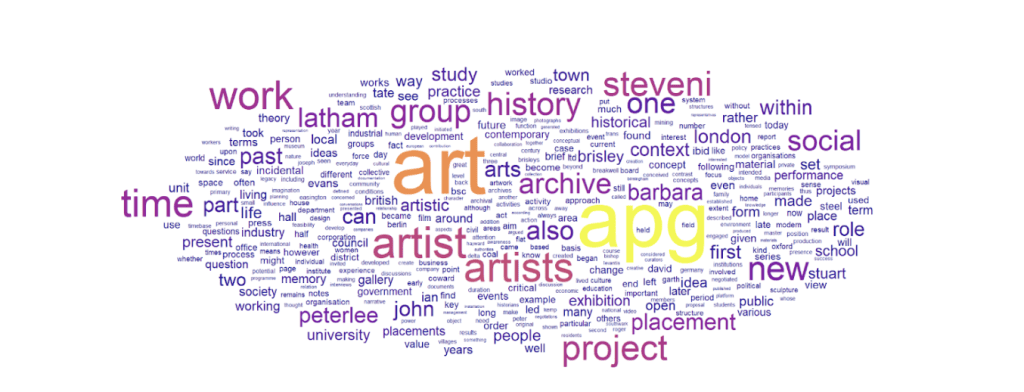The Sculpture x Volunteers: How Volunteers at Modern Art Oxford Activated an Artwork at the Gallery
By Sif Laerke-Hall (Volunteer Coordinator & Studio Assistant)

What do artists do and who gets to be called one?
Is art confined to the studio, or can it emerge from everyday activity, collaboration, and conversation?
How can archives be leveraged as sources for artistic expression?
These are just a few of the thought-provoking questions explored by volunteers in a recent ‘activation’ of The Sculpture as part of the Barbara Steveni: I Find Myself exhibition at Modern Art Oxford.

So, what is The Sculpture? The Sculpture consists of a boardroom table and chairs, but it is so much more than that! While it may at first appear mundane and inconspicuous, this simple set-up can be brought to life (or ‘activated’) through the power of human-interaction. As soon as a group of people take a seat around the table and engage with one another—sharing thoughts and ideas through conversation and collaborative meaning-making—The Sculpture morphs into a dynamic artistic experience. Like many of Steveni’s assemblages created from found objects, The Sculpture embodies a sense of ‘potential’; it represents the idea that, given the right conditions or considered from a certain perspective, anything has the potential to become an artwork.
The Sculpture was originally exhibited in 1971 at the Hayward Gallery, London, and in Düsseldorf, Germany. Members of the Artist Placement Group (AGP), of which Steveni was a founding member, facilitated discussions with various industrialists and government officials around the table. These conversations explored the role of art and artists in the decision-making processes of society. As part of the Barbara Steveni: I Find Myself exhibition, Modern Art Oxford has invited several groups, including Policy Lab and Incidental Unit, to ‘activate’ The Sculpture. A small group of our volunteers were also invited to design and deliver their own take on an ‘activation’.

How did volunteers activate The Sculpture? Over several workshops in April and May, volunteers learned more about Barbara Steveni, the APG, and The Sculpture from our Exhibitions Team. Through conversation and collaborative mind-mapping, volunteers identified several themes, topics, and questions which resonated with the most and would go on to inform their ‘activation’.
Themes discussed included:
- The challenges and barriers to accessing paid work and recognition as an artist within the cultural sector.
- What the role of volunteers in art galleries is.
- Who gets to be called an artist and what kinds of work and processes are (or are not) considered to be art.
- How we might think critically about the boundaries between art/artists and administration/administrators.
- Why socially engaged art works are often associated with an individual artist rather than perceived as co-creations.
- The potential opportunities and dangers that Artificial Intelligence (AI) presents to the art world.
- The idea that archives are more than stores of old documents and may, in fact, provide a means for creating new artworks.

Volunteers also conducted their own independent research. Volunteer David—inspired by the potential for archives to feed into artistic practices—collated APG archival documents to create a word cloud, as well as this striking poem:
One crucial influence planned hospital,
Dystopian viewpoint can reinforce,
Constitute presence, individual
approach, while revisit APG source.
Opposite performance transformed teaching,
Pointed effect, problematic aspects,
Recreation conditions wellbeing,
Given boundaries, past art projects.
Alongside, Barbara Steveni described
Social approach; Government sceptical,
Archaeology’s presence, recorded,
Focusing representative social.
Scientific observation revere,
Incidental person role did appear.

Having decided on the themes for their ‘activation’, volunteers needed to think about how best to communicate their ideas to the visiting public. Wanting to experiment with the format of an ‘activation’, they decided to take a participatory and performative approach. Rather than hosting a formal discussion with a set agenda, volunteers opted for a workshop which invited visitors to explore themes through conversation, collage-making, and poetry-writing.

The Sculpture table was set up with shredded newspapers, magazines, research papers, and reproductions of archival documents. Reminiscent of Anne Bean’s commissioned performance on the opening night of the exhibition, the workshop encouraged visitors to combine fragments of words to produce new compositions. The ‘activation’ was a great success, with several members of the public and staff at Modern Art Oxford joining in and bringing a new energy to the gallery space.
This project was not only for the benefit of visitors to Modern Art Oxford. It was also an opportunity for members of the volunteering community to get involved with the gallery in a more actively creative way, feeding their voices and ideas directly into the exhibition. In the words of one of the volunteers involved, Tasha:
“I found this aspect [The Sculpture piece] of the exhibit and purpose of the APG to be very relatable. I grew up with a love for art, studied a humanities course at university, have worked in clerical and administrative roles since graduating and currently create and learn about art in my spare time. This mixture of interests in art, research and analysis, with technical and creative skills seems contrasting, but Steveni’s work highlights how the arts, business, leisure and employment coalesce. In an ideal world, I would make art for a living, but as it turns out, I do!”
Read more about Tasha’s experience of being involved in the project here.
Thank you again to the amazing volunteers involved in the project: David Barron, Sehar Kharawala, Bella Howe, Tasha Versfeld-Steere, and Anisah Rokib.
Find out more about the volunteering programme at Modern Art Oxford.
